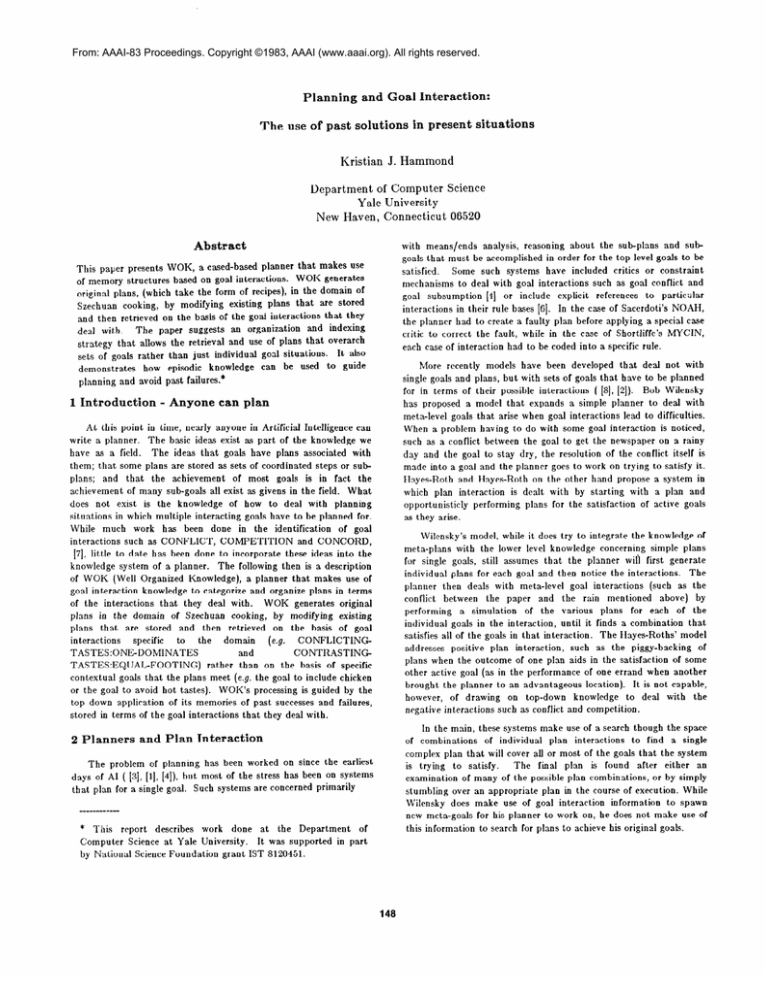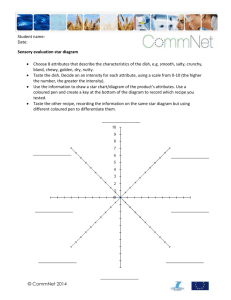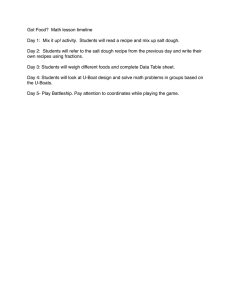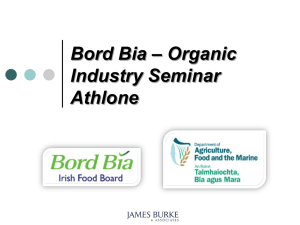
From: AAAI-83 Proceedings. Copyright ©1983, AAAI (www.aaai.org). All rights reserved.
Planning and Goal Interaction:
The use of past solutions in present situations
Kristian
J. Hammond
Department
of Computer
Yale University
New Haven, Connecticut
Abstract
More recently models have been developed that deal not with
single goals and plans, but with sets of goals that have to be planned
for in terms of their possible interactions
( IS], [2]). Bob Wilensky
has proposed a model that expands a simple planner to deal with
meta-level goals that arise when goal interactions lead to difficulties.
When a problem having to do with some goal interaction is noticed,
such as a conflict between the goal to get the newspaper on a rainy
day and the goal to stay dry, the resolution of the conflict itself is
made into a goal and the planner goes to work on trying to satisfy it.
EIayes-Roth and Hayes-Roth on the other hand propose a system in
which plan interaction
is dealt with by starting with a plan and
opportunisticly
performing plans for the satisfaction of active goals
as they arise.
and avoid past failures.*
1 Introductiou
06520
with means/ends
analysis, reasoning about the sub-plans and subgoals that must be accomplished in order for the top level goals to be
satisfied.
Some such systems have included critics or constraint
mechanisms to deal with goal interactions such as goal conflict and
goal subsumption
[4] or include explicit references to particular
interactions in their rule bases [s]. In the case of Sacerdoti’s NOAH,
the planner had to create a faulty plan before applying a special case
critic to correct the fault, while in the case of Shortliffe’s MYCIN,
each case of interaction had to be coded into a specific rule.
This payer presents WOK, a cased-based planner that makes use
of memory structures based on goal interactions. WOK generates
original plans, (which take the form of recipes), in the domain of
Szechuan cooking, by modifying existing plans that are stored
and then retrieved on the basis of the goal interactions that they
The paper suggests an organization
and indexing
deal with.
strategy that allows the retrieval and use of plans that overarch
sets of goals rather than just individual goal situations.
It also
demonstrates
how episodic knowledge can be used to guide
planning
Science
- Anyone can plan
At this point in time, nearly anyone in Artificial Intelligence can
write a planner.
The basic ideas exist as part of the knowledge we
have as a field. The ideas that goals have plans associated with
them; that some plans are stored as sets of coordinated steps or subplans; and that the achievement
of most goals is in fact the
achievement of many sub-goals all exist as givens in the field. What
does not exist is the knowledge of how to deal with planning
situations in which multiple interacting goals have to be planned for.
While much work has been done in the identification
of goal
interactions such as CONFLICT, COMPETITION
and CONCORD,
[7], little to date has been done to incorporate these ideas into the
knowledge system of a planner.
The following then is a description
of WOK (Well Organized Knowledge), a planner that makes use of
goal interaction knowledge to categorize and organize plans in terms
of the interactions
that they deal with.
WOK generates original
plans in the domain of Szechuan cooking, by modifying existing
plans that are stored and then retrieved on the basis of goal
interactions
specific
to
the
domain
CONFLICTING
(e.g.
TASTES:ONE-DOMINATES
and
CONTRASTING
TASTES:E&UAL-FOOTING)
rather than on the basis of specific
contextual goals that the plans meet (e.g. the goal to include chicken
or the goal to avoid hot tastes). WOK’s processing is guided by the
top down application of its memories of past successes and failures,
stored in terms of the goal interactions that they deal with.
Wilcnsky’s model, while it does try to integrate the knowledge of
meta-plans with the lower level knowledge concerning simple plans
for single goals, still assumes that the planner wiil first generate
individual plans for each goal and then notice the interactions.
The
planner then deals with meta-level goal interactions
(such as the
conflict between the paper and the rain mentioned
above) by
performing
a simulation
of the various plans for each of the
individual goals in the interaction, until it finds a combination that
satisfies all of the goals in that interaction.
The Hayes-Roths’ model
addresses positive plan interaction,
such as the piggy-backing
of
plans when the outcome of one plan aids in the satisfaction of some
other active goal (as in the performance of one errand when another
brought the planner to an advantageous
location). It is not capable,
however, of drawing on top-down
knowledge to deal with the
negative interactions such as conflict and competition.
In the main, these systems make use of a search though the space
of combinations
of individual
plan interactions
to find a single
complex plan that will cover all or most of the goals that the system
is trying to satisfy.
The final plan is found after either an
examination of many of the possible plan combinations, or by simply
stumbling over an appropriate plan in the course of execution. While
Wilensky does make use of goal interaction
information
to spawn
new meta-goals for his planner to work on, he does not make use of
this information to search for plans to achieve his original goals.
2 Planners and Plan Interaction
The problem of planning has been worked on since the earliest
days of AI ( [3], [l], [4]), b u t most of the stress has been on systems
that plan for a single goal. Such systems are concerned primarily
““““““““““* This report describes work done at the Department
of
Computer Science at Yale University.
It was supported in part
by National Science Foundation grant IST 8120451.
148
3 WOK
- A different sort of planner
3.1 Planning
for rather
than
against interactions
The WOK project takes a somewhat
different approach
to
The program
makes use of its knowledge
of goal
planning.
interactions
to organize plans and tries to make use of plans that
overarch and satisfy a set of goals rather than find a plan for each
individual go31 and try to combine them. WOK is designed to be an
interactive program that is given a set of constraints by the user and
then provides a recipe that meets them. The constraints come in the
form of requests
for certain
ingredients,
(i.e. chicken,
water
chestnuts, scallions), particular
tastes, (d.e. hot, spicy, bland), and
textures, (i.e. crunchy, gelatinous, chewy). The output is a natural
language description
of the dish and the recipe that has to be
followed to make it. WOK functions by finding an existing plan or
recipe that in some sense fits its current set of goals, and modifying
it to provide a plan that precisely matches those goals. WOK does
not ever try to build up a recipe from scratch. It instead is reminded
of old recipes that deal with situations analogous to the one it is
working on and alters them to fit its current needs.
3.2 Knowledge
and the organization
of knowledge
WOK begins with a knowledge base of recipes; descriptions of
ingredients;
descriptions
of physical
scenes that correspond
to
preparation
and cooking steps such as CHOP or STIR-FRY as well
as a set of primitive
alteration
steps that allow it to ADD,
REPLACE and REMOVE ingredients from a recipe. Recipes take
the form of sequential orderings of preparation
and cooking steps
which include listings of all ingredients used in the plan. Beyond
this, the initial recipes include information
pointing
out the
interesting tastes and textures that result from the execution of the
plan (this normally includes the major ingredients as well as any
strong spices) and information about any interesting interactions of
tsstes that occur in the recipe (i.e. the contrast between the savory
taste of pork and the sweet taste of hoisin in PORK SHREDS WITH
HOISIN or the conflict that is dealt with between the licorice taste of
star anise and the salty taste of the cooked down soy sauce in
ANISE CHICKEN).
Recipes stored in memory are indexed in three different ways.
Each is indexed under the important
foods and tastes that are
included in the recipe, making it possible to retrieve a recipe for an
individual
ingredient
or taste, such as CHICKEN
or GINGER.
Recipes are also stored under the individual preparation
and cooking
steps that they make use of. This makes it possible to retrieve
recipes on the basis of some particular step that might be important
in the current situation, such 3s finding a recipe that includes the
MIX and FORM steps necessary to any ground meat dish.
These two means of indexing, while useful in the case of single
goal request,s such as those for just chicken or just ground beef, are
of little value when a set of taste and ingredient goals are to be
satisfied.
Once the system has to deal with goals in interaction, it is
important that it be able to retrieve plans on the basis of something
other than a single ingredient or step. Given a request for a dish
that includes chicken and oranges for example, it is less important to
look at all of the chicken dishes or all of the recipes that have
oranges, than it is to find a recipe that has already confronted the
problem of combining a savory and sweet taste of equal strength.
Because of this, all recipes are indexed under the taste interactions
that they deal with. Thus PORK SIRREDS WITH HOISIN is stored
under a structure that contains knowledge about contrasting tastes
where
both
tastes
are of equal strength
(CONTRASTING
TASTE:EQUAL-FOOTING)
because it deals with a situation
in
which that interaction has been incorporated
into a successful plan,
in th3t it includes both the ssvory PORK and the sweet HOISIN.
ANISE CIIICKEN is stored under a similar structure for conflicting
tastrs where one taste overpowers
the other (CONFLICTING
TASTE:ONE-DOMINATES)
b ecause it deals with this interaction by
including both the salty taste of SOY-SAUCE and the licorice taste
of STAR-ANISE.
This indexing is by far the most important of the
three when dealing with interacting goals in that it allows
the use of
recipes that solve problems which are are anslogous to a current
processing situation rather than just those that include the same
ingredients or tastes.
3.3 The
structure
of interactions
WOK uses the categories
defined by taste interactions
3s
knowledge structures under which are stored plans that have been
developed to cope with the interactions
themselves.
Rather than
stsrting with a set of goals and planning for each until some goal
interaction
blocks norm31 processing, WOK begins by trying to
identify the interactions
between the goals it is planning for and
se3rching for plans designed to deal with those interactions.
The
knowledge structures used 3re domain specific versions of Schank’s
Thematic Organization Packets or TOPS [*5]and owe a great deal to
the categorization
proposed
by Wilensky [7].
The categories
themselves are made up of two components.
First there is the
relationship
between the t3stes alone, which includes interactions
such as CONTRASTING-TASTE,
CONFLICTING-TASTE
and
AGREEING-TASTE.
There also is the effect of the interaction,
which
includes
ONE-DOMINATES,
EQUAL-FOOTING
and
BLENDING.
WOK makes use of nine separate categories
effect. The more important of these includes:
o CONTRASTING
TASTE
(ex. hot and savory)
: ONE
e CONTRASTING
TASTE
(ex. sweet and sour)
: EQUAL
e CONFLICTING
TASTES
(ex. soy sauce and holsln)
: ONE
o CONFLICTING
TASTES
(ex. garlic and hoisin)
: EQUAL
* DIFFERENT
TASTES
: BLEND
of interaction
and
DOMINATES
FOOTING
DOMINATES
FOOTING
(ex. garlic
and
nuts)
e DIFFERENT
TASTES
(ex. pork and trees ear)
: BALANCED
TASTES
Esch of these structures organizes four sorts of planning
relevant to the particular interaction.
information
o Specific plans that deal with the interaction (i.e.
particular
recipes that handle taste conflicts or
instances
of an over abundance
of agreeing
tastes).
strategies
for
dealing
with
the
e General
a contrasting
taste
to
interaction
(i.e. add
undercut a conflict between two others, spice up
a basicly homogeneous dish that is weak or add
a dull tasting buffer to a dish that has become
too strong).
o Indexing information
about what aspects of the
plan are important to the interaction and should
thus be used in storage and retrieval (i.e. index
by the dominating
taste in the interaction
or
of other interactions).
presence
o Instances of failures of plans and strategies that
are used to avoid similar mistakes.
(i.e. Recipes
that simply didn’t taste particularly good)
4 WOK
4.1 The
- An example
basic
algorithm
The processing in WOK can be broken down into four major
steps. First, the system must sort the goals given to it by the user
and identify the taste interactions that will be useful to it in finding
a plan to deal with that combination of goals. Second, it uses the
abstract interaction,
and the particulars of the goals to find a plan
that overarches a major segment of the goals as well as the effects of
their interaction.
Third, the plan is modified to fit all of the current
user goals. Fourth, the interactions of new tastes that have resulted
from the modifications
are checked for their similarity
to past
failures, and are changed if necessary.
Once this is done the new
recipe is indexed into the existing data base in terms of the new
interactions
that are dealt with by the plan.
What each of these
steps actually means can be best seen through a look at excerpts
from one example of the system trying to build a recipe for the user
request of a dish with CHICKEN and MANDARIN ORANGES.
In
the rest of this paper, boldfaced type will be actual output from the
program itself.
4.2
Sorting
possible plan, because it is under here that that plans dealing with
the sort of interaction exemplified by the relationship between the
chicken and orange are stored.
goals
and identifying
interactions
The goals that the system is given are sorted by their relative
importance in the present data base. Given that each recipe begins
with knowledge of which tastes and ingredients are important,
as
well as which participate in the interactions that the recipe handles,
it is easy to assess the relative importance
of two ingredients or
tastes by a comparison
of the extent to which they have been
important in the past. The importance of a taste or ingredient then
is a dynamic value that is the function of how many recipes it is
included in, how often it is considered important to those recipes by
itself, and how often it is important
when interacting
with other
tastes in those recipes.
This last aspect of a taste or ingredient’s
importance
tends to be the most significant,
in that most of the
indexing is done in terms of interactions, and a taste that has many
interesting
interactions
with others will provide a richer set of
indexing possibilities. For example, the hot taste of RED-PEPPER
interacts with many more tastes in the recipes that the system begins
with, than the taste of CHICKEN.
A user goal to have RED
PEPPER then would be considered more important that one to have
CI IIC’KEN.
Once the goals are sorted, the most important ones are compared
in a pairwise fashion, and the interaction
between them is found.
This is done by a simple table look up of the combination of tastes
In the example of the chicken and
associated with the goals.
is CONTRASTING-TASTE:EQUALthe
interaction
oranges,
FOOTING, which is to say, the tastes contrast, and they are of the
same intensity.
This memory structure is then searched for a
4.3 Indexing
and search
Once an interaction
is identified, it guides the processing that
In the
case of CONTRASTING-TASTE:EQUALfollows.
FOOTING,
the structure itself knows that both of the tastes are
important
to use in indexing, and that acceptable recipes include
those that match both tastes in the current interaction or those that
match one ingredient of the interaction but not both tastes.
This
with
the
structure
CONTRASTING-TASTE:ONEcontrasts
DOMINATES
which knows that the dominant
taste is more
important than the dominated and that this must be matched for a
recipe to be used.
In the case of the CHICKEN and ORANGE
example, the recipe that is found, PORK SHREDS WITH HOISIN
SAUCE, is indexed by the tastes alone, savory and sweet, under the
interaction CONTRASTING-TASTE:EQUAL-FOOTING.
The goals are ranked as follows:
Goal to include chicken
Goal to include mandarin orange
Searching
ingredients
Searching
for recipes
including
direct relations
between
and tastes.
CONTRASTING-TASTE:EQUAL-FOOTING
I have found PORK
The recipe includes:
SHREDS WITH HOISIN SAUCE.
Bork, scallion, soy sauce and hotsin.
The recipe was chosen because the relation in which the
savory taste of the pork contrasts with the sweet taste of
hoisin sauce is similar to the relation
between the two goals
to include chicken and to include mandarin orange .
4.4 Modification
of plans
Once a recipe is found, it has to be modified to cover the goals of
the original request. As in the case of this example, the recipe may
not include any of the ingredients requested, though it does handle
the effect of the interaction between them.
Given that the system
knows how it found the recipe, it also knows what the mapping
between the original goals and the existing plan is. The fact that it
found the recipe because of the similarity between the interaction of
the PORK and HOISIN and that of the CHICKEN and ORANGE
gives it the information
that the CHICKEN and ORANGE map
directly onto the PORK and IIOISIN. This information
allows it to
know to do a simple replacement in this case. In cases where 3 new
ingredient does not satisfy all of the important goals of the one being
removed the system has to add a further ingredient that will satisfy
the now active goal.
following
goals
still have
Goal to include chicken
Goal to include mandarin
Mapping
Mapping
orange
chicken to pork...Replacing
mandarin
orange to hoisin sauce...Replacing.
4.5
New
interactions
and avoiding
past
failures
Once a new recipe is built, the system examines the new taste
interactions that have developed, in an effort to avoid any mistakes
that it has made in the past.
It does this by looking at the
interactions
between the important
tastes in what remains of the
original recipe, (as stated before, these are explicitly noted in the
recipe itself), and the important tastes, (in the global sense of having
been important in past recipes), that have been added. The purpose
have to be
First, the new interactions
of this step is twofold.
understood by the system so that it can index the new recipe in
terms of them. More importantly
for the recipe itself, the system is
also making sure that no new interaction has come about that is
similar to any past failure. Failures are actual recipes that do not
succeed in dealing with the interactions
they include.
If such a
failure is found (by going though the same sort of search that was
used to find the original recipe, but with the interactions
in the
current recipe rather than the user goals), then the interaction
associated with it is again used to provide a new plan to deal with
the problem.
In this example, a problem is discovered with the new
ORANGE and the old SCALLION, and the resulting interaction,
CONFLICTING-TASTES:ONE-DOMINATES
provides an alternate
plan of finding a new dominating taste for the ORANGE.
The new
taste is found by looking for a contrasting
taste in any recipe, but
the search is guided by the context of the current situation.
Thinking about the relations between the following
The savory taste of the chicken.
The sweet taste of the mandarin
orange.
The fresh, vegetable taste of the scallion.
tastes:
In CHICKEN
WITH PEANUTS
The hot and spicy taste of the red pepper contrasts
and dominates the savory taste of the chicken.
Replacing
with
the Scallion with Red pepper.
Once all new interactions have been validated, the new recipe is
indexed in the data base in terms of those interactions.
5 Conclusions
By organizing plans by the goal interactions that they deal with,
the 1VOK planner is able to access and use complex plans that
The
overarch a set of goals, rather than just meet single goals.
memory structures related to these interactions are able to guide the
planning process in many ways. They provide instances of both
successful plans and failures, general strategies for dealing with the
related goal interaction and indexing information which guides search
and the later mapping between current problems and past solutions.
This information allows the system to find appropriate
plans on the
basis of goal interactions, modify them to meet current constraints,
avoid repeating past failures and make use of 3 various number of
grnr,rxl planning
strategies
that are organized
applicable
to the
specific interaction.
The system avoids the use of special purpose
and time consuming
simulations
by anticipating
the
critics
interactions
between goals and finding an overarching
plan rather
than waiting for the problems of interactions to interrupt processing.
There Is a problem with the relationship hetween the
Mandarin orange and the Scallion. I am reminded of
the failure in the ORANGE
AND OLIVE SALAD.
In the ORANGE
AND OLIVE SALAD the relationship
between the Onion and the Mandarin orange was
considered
Iteferences
to be a failure.
Fikes,
R.,
In this recipe The fresh, vegetable taste of the onion contrasts with and
dominates the sweet taste of the mandarin orange.
r11
The plan used in this recipe - STAND-ALONE
as the plan in the failed recipe.
[21 Hayes-Roth,
- is the same
Trying general plans From TOP
CONTRASTINGTASTES:ONE-DOMINATES
TOP
has 2. plans: STAND-ALONE
Plan STAND-ALONE
has already
ORANGE
AND OLIVE SALAD.
failed in the recipe for
Plan is to replace the ScalEon.
Looking for item in TOP
CONTRASTINGTASTES:ONE-DOMINATES
- Red pepper.
the
and
Nilsson,
application
B.,
131 Newell,
A.,
general
Shau,
[41 Sacerdoti,
House,
E.D.
Technical
Center,
J.C.,
109,
Simon,
Model
of
H.A.
'Report
on
a
In
Proceedings
of
on Information
Processing.
Paris,
SRI
problem
1979.
program"
1959.
'A structure
Report
approach
to
'A Cognitive
3(4),
and
Conference
UNESCO
F.
Science
A new
proving
$ 1971.
Intelligence
problem-solving
the international
UNESCD,
#STRIPS:
theorem
Hayes-Roth,
Cognitive
Planning"
N.J.
of
Artificial
solving.'
and REPLACE-OBI
Avoiding past failure - Trying REPLACEQBl
This plan is to replace the dominating taste with another.
The relation
is preserved, with B new taste.
Found a possible contrast
to
for
plans
Artificial
and
behavior.m
Intelligence
1975.
Dynamic
Memory: A theory of learning in
[51 Schank, R.C.
computcra and people. Cambridge
University
Press,
1982.
[a
Short
I iffe,
MYCIN.
[71 Wilensky
PhD
[81
,
College
R.
Computer-baaed
Elsevier,
Understanding
R.
thes is,
Wilensky,
UCB
E.H.
American
Yale
University
New
Goal-Baaed Stories.
1978. Research
Repor t #140.
,
AlETA-PI,ANNING.
of
Engineering,
medical consultations:
1976.
York,
Techn ica I Report
August
1980.
W80
33,





